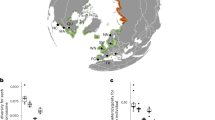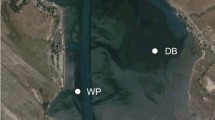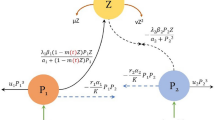Abstract
IN Dr. Kathleen B. Blackburn's letter on this subject1, the conclusion seems well established, through a study of the chromosomes, that the narrow-leaved form of the eelgrass (grass wrack), which has in many of the diseased areas replaced the larger and broader type of plant, is clearly a form of Z. marina and not a hybrid of Z. marina and Z. nana, as some have believed. Miss Blackburn therefore suggests that the difference in the width of the leaves of varieties of Z. marina may be a purely ecological character. She further remarks that, in the localities examined, the width of the leaf of Z. marina was directly proportional to the depth of the water, and that the very narrow-leaved forms Were those that had been longest exposed by the fall of the tide, while the broader were those that had not been exposed at all.
This is a preview of subscription content, access via your institution
Access options
Subscribe to this journal
Receive 51 print issues and online access
$199.00 per year
only $3.90 per issue
Buy this article
- Purchase on SpringerLink
- Instant access to full article PDF
Prices may be subject to local taxes which are calculated during checkout
Similar content being viewed by others
References
NATURE, 134, 738; 1934.
Univ. Calif. Publ. Bot., 14, No. 19,389–452; 1929.
Author information
Authors and Affiliations
Rights and permissions
About this article
Cite this article
COTTAM, C. Wasting Disease of Zostera marina. Nature 135, 306 (1935). https://doi.org/10.1038/135306a0
Issue date:
DOI: https://doi.org/10.1038/135306a0
This article is cited by
-
Special Issue Oceans and Humans Health: The Ecology of Marine Opportunists
Microbial Ecology (2013)
-
Germination of Oospores of Onion Mildew, Peronospora Schleideniana W. G. Sm
Nature (1937)
-
Wasting Disease of Zostera marina
Nature (1935)
-
Biology of Growth and Breeding
Nature (1935)
-
Germination of Resting Fungal Spores
Nature (1935)



